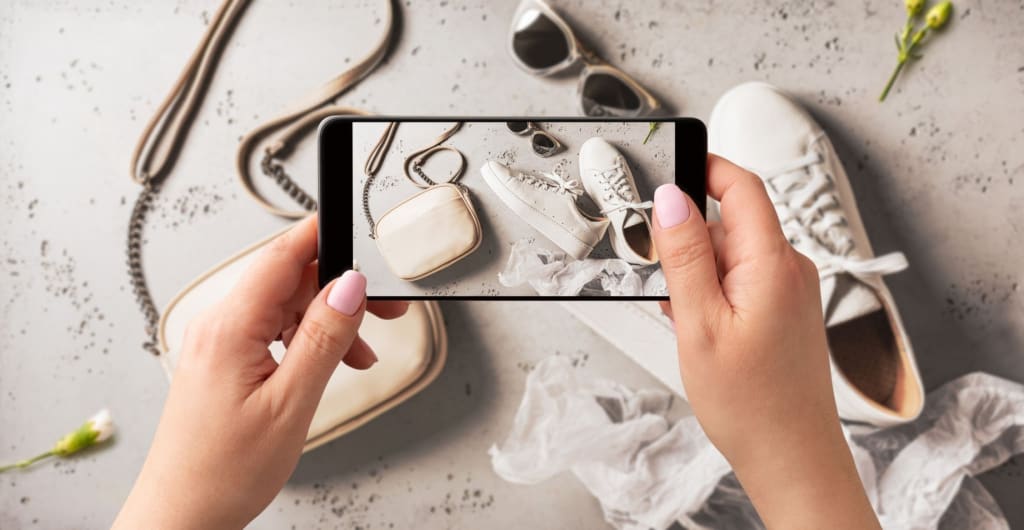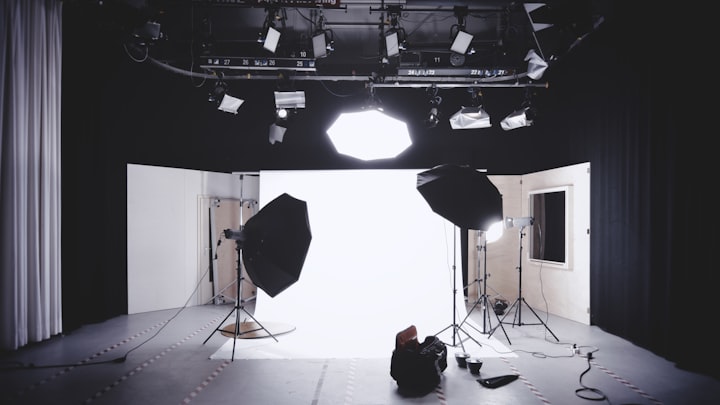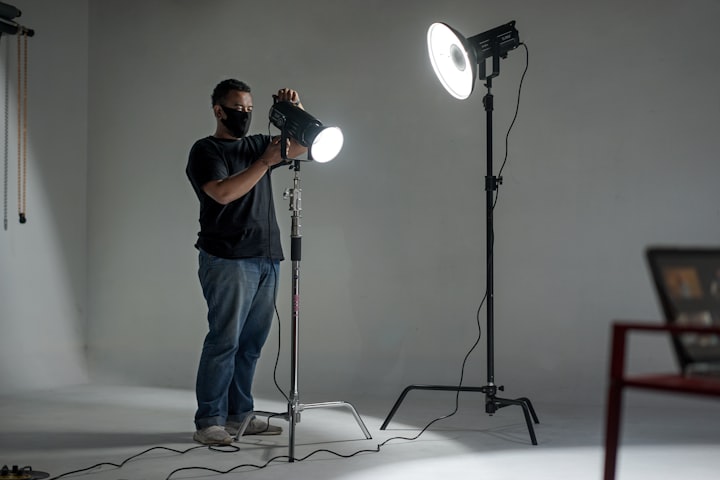The Product Photography Checklist: A Step-By-Step Guide
Product photography is the art of creating visually appealing images of products that are designed to convince customers to buy them. If done right, product photography can help a brand build trust with customers, increase product visibility on social media, and improve organic search ranking.

What is Product Photography?
Product photography is the process of capturing high-quality images of products, such as food, clothing, and accessories. It involves using a variety of different camera settings and equipment to ensure that product shots are authentic, appealing, and professional-looking.
- What equipment is needed for product photography? The most important pieces of equipment include a tripod, camera body, lens, and background. You can also use special lighting such as studio lights to enhance the natural light on your product shots.
- How to set up a product photography studio? If you've never taken product photos before, it's best to start small and build your setup gradually. Here's an outline of the essentials for a product photography studio: background (use white or light-colored surfaces), camera setup (tripod, lens cap, and camera body), light sources (studio lights), background props (cushions, boxes, books), and accessories (stands).
- What are the best practices for taking product photos? When shooting product photography for online stores or other commercial purposes, it's important to consider your audience's expectations. Also, consider natural lighting conditions when taking photos outdoors.
- How can post-processing improve product photography results? Post-processing refers to editing images after they've been taken. This could involve adjusting white balance, exposure compensation, or other settings to improve image quality. You can also use image editing software or photo editing apps to add effects or adjust settings.
Why is Product Photography Important?
- Product photography helps to showcase the quality and features of a product.
- It can help potential customers make an informed decision about purchasing.
- Professional product photos can help boost sales and brand recognition.
- High-quality product photos create a more immersive online shopping experience. This can help to create a better overall customer experience.
- It is vital for brands to invest in professional product photography to ensure high-quality images are received by audiences.
Conveys Product Quality
Product photography is an essential tool for creating high-quality visual representations of a product. In general, product photography can be used to showcase features, materials, and other details that cannot be seen in traditional advertising. For example, product photographs may show different angles or poses to showcase a product's versatility or suitability for different purposes.
High-quality images help to create a sense of trust and credibility with consumers, which can lead to increased sales. By conveying the quality of a product through visual representation, product photography helps companies stand out from competitors and build brand recognition. Overall, product photography plays an important role in helping companies sell their products effectively and efficiently.
Builds Brand Recognition
Product photography is essential for any business that sells products online. It helps customers visualize the product and how it might look in their home or on their person. High-quality product images can help build brand recognition, as customers will associate your product with a specific look and style. Moreover, product photography is useful for promoting your products online as it provides detailed images of the product that can showcase its features. This helps customers make informed decisions about the purchase. Additionally, quality photographs help boost sales by providing shoppers with visual proof of the product’s quality and durability.
Overall, good product photography can help you stand out from competitors who do not have professional-looking images. So be sure to spend time and effort on creating compelling photos that show your product in its best light.
Increases Conversion Rates
- Product photography is an essential tool for online retailers, as it helps it to increase conversion rates. High-quality product photos are more likely to attract customers and encourage them to purchase. By showing customers the product in a realistic light and from different angles, product photos help reduce hesitation and anxiety about making a purchasing decision. This ultimately results in higher sales volume and better conversion rates.
- Another important function of product photography is to showcase unique features of a product and help differentiate it from similar products. It can also be used to show the size, color, and texture of the product, allowing customers to get a better sense of the size, quality, and potential value they may get from making the purchase.
- To maximize the effectiveness of their photo content, online retailers should take into account several factors, including lighting setup and background options. Product photos should be done in a way that accurately conveys the product's features while emphasizing its best qualities.
Gives Visual Clarity to the Customer
Product photography is important because it gives customers visual clarity of the product they are looking to purchase. High-quality product photos can help create an emotional connection with the customer and make them more likely to purchase. It’s vital that product photos show all angles of the product and capture it in natural light. Using props and complementary backgrounds can add interest and depth to your photos. You should use consistent lighting, editing, and styling for all of your product photos. This will help ensure they all look professional and consistent. When taking product photos, it’s important to keep in mind the overall goal of showing off the product in its best light.
Enhances Social Media Presence
Product photography can help businesses stand out from the competition and attract customers. It is essential for businesses to create engaging content for their social media platforms, websites, and any other digital media. High-quality images of products can help companies build a reputation for quality and reliability. Besides, product photography can also be used to create engaging content for corporate social media pages or blogs. It is vital to choose the right equipment, lighting, and background to ensure the best results. Overall, product photography plays a crucial role in creating high-quality visual content that can help businesses grow and thrive in today’s digital world.
Step 1: Choose the Right Equipment

Before you begin a product photography shoot, it's important to consider the type of lens and camera you'll use. Choose a lens that is capable of capturing the largest possible image frame, while also taking into consideration its focal length, aperture, and other specifications. It's best to select a lens with an equivalent focal length to your camera body's focal length.
If possible, try using natural light when shooting product photos. However, if you're shooting in artificial light, consider using different types of lighting such as reflectors or softboxes. Select lighting equipment that will help highlight the product’s features and color well. If you are shooting outdoors, consider using a white background instead of black or grey ones for better contrast and visibility.
Also consider props that can add interest and dimension to the product photos. You can include items like product tags or labels in the photos for added authenticity or even include props that are relevant to the product's theme. By following these tips, you can create product photos that are professional and engaging
Step 2: Ensure Lighting and Color Accuracy

- Use a lightbox or softbox to evenly distribute light on the product. This will help ensure good lighting for your product photography.
- Utilize a white balance card to accurately represent the color of your product in the photo. This will help ensure that your product looks its best and is visible in the photo.
- Adjust the ISO, aperture, and shutter speed of your camera for optimal lighting. This will help you capture photos with sharp, vibrant details and vibrant colors. Take multiple shots with different angles and settings to ensure you get the best results.
- Also, consider using a tripod or other stable platform for your product photography. This will help you avoid missing any important details due to shaky hands or camera movements.
Step 3: Find the Best Camera Settings

- Choose the white balance setting that best matches the lighting conditions.
- For natural light photography, use a white balance setting of 'incandescent.'
- For artificial light photography, use a white balance setting of 'auto.'
- If using flash, use a white balance setting of 'automatic.'
- Set the correct ISO levels and shutter speed to capture the image without creating any artificial exposure blur.
- Adjust the aperture to get the desired depth of field.
- Use a tripod for steady, sharp images.
- Utilize natural and artificial light sources for best results.
Camera Setting Guide for Product Photography
Step 4: Use Depth of Field Effectively
In photography, "depth of field" refers to the area in an image that appears sharp. A shallow depth of field means the focus is sharp in the middle of the photo and blurry outside of that area. On the other hand, a deep depth of field means everything appears sharp within a certain focal distance—that is, without any distractions.
When choosing an aperture for photography, you need to consider how you want your product to look in the photo. You can create a shallow or deep depth of field effect using different apertures, such as f/1.4, f/2.8, f/4, f/5.6, and so on.
Another way to create a shallow or deep depth of field effect is by utilizing a tripod and focusing stacking. This entails taking photos at different focal lengths with different apertures to create a series of images with different depths of field from wide-angle to telephoto shots.
You can also use the "bokeh" effect for product photography to make your product stand out from its background. This involves focusing on a product's edges or highlights for an artistic effect.
Step 5: Capture Multiple Angles for Maximum Impact
After completing step 4, you should have great product images ready to share online. However, there are a few tips and considerations that can help create the best product photos for online marketing.
- Shoot the product from multiple angles to show off its features more effectively. This will help consumers get a better idea of the product’s overall design and purpose. Additionally, props can be used to creatively showcase your product in ways that wouldn't be possible with just product photography alone. This can include using natural light for more flattering shots or adding filters or lighting effects to enhance natural lighting for an interesting effect.
- When taking product photos with natural light, use a tripod and remote shutter release to get sharper images without camera shake. This will ensure that your images are as sharp and vibrant as possible.
Overall, the product photography is an important part of any online marketing campaign. By following the steps outlined above, you can create great product images that will help drive sales and increase brand recognition.
Step 6: Pay Attention to the Image Background

When it comes to product photography, the background is arguably the most important aspect. A great background can make or break an image, and it's essential to choose one that complements the product and suits your brand image. To get started, consider the type of product you're photographing. If the product is white or light-colored, a simple background such as a white backdrop or a solid color may be effective. On the other hand, if the product is darker in tone, try using a background with a simple pattern or texture instead.
Another factor to consider is your photography style. Do you prefer natural light photography? Then try using a background that's consistent with the natural elements of the scene. If you prefer artificial lighting, consider using a backdrop with similar lighting effects. Besides, there are many other tips and tricks for product photography that can help you create captivating images.
Step 7: Post-Production Editing

After the photo shoot, the next step is post-production editing. This includes color correction, cropping, retouching, and sharpening. The goal of post-production editing is to create a photo that is true-to-life and balanced. After reviewing and selecting the photos, you’ll want to adjust colors to make them look natural and balanced. This includes white balance, exposure, and tone. You’ll also want to trim any unwanted elements or distractions from the photo so that it's focused on the subject and readable.
The final stage of post-production editing involves re-framing the image by either cropping or framing it with a preset size. This will determine the overall look and feel of the photo. Additionally, you can adjust images by fine-tuning angles or angles of shots to better capture your desired scene or angle.
A product photography checklist helps you organize product photography projects effectively. It provides tips on what product photography terms mean, how to plan product photography sessions, how to use product photography equipment and accessories, and how to optimize product photography results.
Final Thoughts
When it comes to product photography, quality and professionalism are the two main factors to consider. The lighting, background, angles, and framing of product photos should all be thoughtfully planned to capture the best possible shots.
It is vital to take multiple shots from different angles using a high-quality camera to capture every detail of the product. Post-production such as editing and enhancing photos with digital filters can be instrumental in creating polished product images.
By using product photography software, you can streamline the process and ensure high-quality images are captured with consistency. Not only that, but product photography tips can also help you create great product photography portfolios.
Conclusion
As product photography is a vital part of online shopping, product photography deserves as much attention as product design and other elements of product page design. To take great product photos, you need good lighting, background choices, and angles. Using product photography tips can help you create high-quality images that enhance the product, allowing shoppers to better visualize your product. So if you're looking to improve product photography skills while saving time and money, try our product photography retouching checklist today! We offer a free consultation to help you get started with product photography.
About the Creator
MD Samiul Islam
I'm a photographer based in the Dallas/Fort Worth area. With over Five years of experience, I have the knowledge and expertise to capture memories that will last a lifetime.






Comments
There are no comments for this story
Be the first to respond and start the conversation.